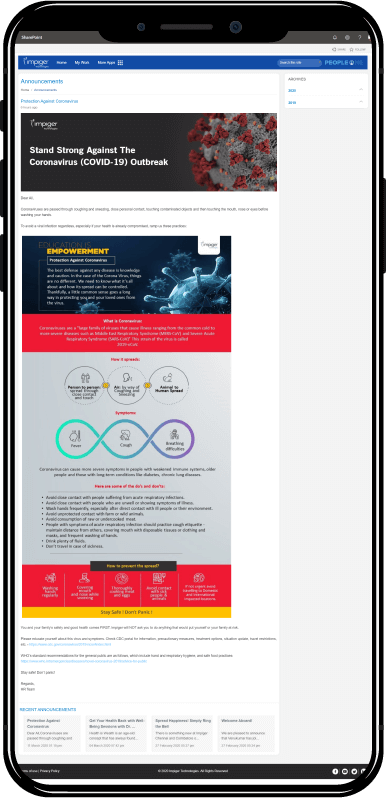
When disaster strikes, who you gonna call? COVID-19 is hitting hard. In fact, as per the World Economic Forum, global pandemics cost the global economy around $570 billion every year! While many organizations come to a halt during such times, those who have a continuity plan in place, persist. Work from home is making up for an integral part of the continuity plan.
In the wake of Covid-19, companies are making the decision to temporarily dismantle HQs in favor of work from home solutions. For many, this is the first time to face such a crisis and logistically speaking there are a lot of problems in communication.
Fewer than half of companies have a crisis playbook ready to use—and one third of board members don’t even know if they do.
There’s a need for swift action to develop a plan that can be shared with your distributed employees quickly. Here are some must-have tips you can implement during a crisis today.
Mitigate Risk with a Virtual Home Base
There needs to be a central point of authority, a single source of truth. Without one, rumors and misinformation can spread like wildfire. When employees become distributed remotely, they flock to the internet online for real-time updates.
Companies operating in a remote environment adopt an intranet, or internal workspace, for all their communication and collaboration needs. The best intranets are able to integrate with other productivity tools your employees are already using by housing everything on one personalized dashboard.
Imagine if instead of sending email after email, leadership could have a centralized news and announcements platform to serve as a single voice of the company that unifies everyone with the same core values. You can mitigate widespread panic by quelling fear with authority and confidence on operational leadership.

Create Fact Sheets For the Crisis
Knowledge is power. When widespread panic erupts your employees are going to have lots of questions. Gather a list of the most common questions that flood your inbox and work with creative to create a fact sheet that addresses them in a simple format. Beyond immediate employee inquiries, your fact sheet serves as a powerful piece of collateral for the crisis subject.
With a pandemic like COVID-19, you can include the research findings of diagnostics, treatment and prevention to inform your employees how best to respond.
Fact sheets can be distributed via email or stored on a public platform like SharePoint’s OneDrive for quick reference. Employees can even receive push notifications for real-time updates. Here’s an example of one fact sheet we made at Impiger.

Establish Notification and Monitoring Systems
Crisis management in 2020 requires an omni-channel approach to information dissemination. Your employees will not always be in front of their computers or at their desks. When updates are happening on the minute-by-minute frequency, it’s important you can reach everyone quickly.
Mobile apps, SMS, social media, and email are some channels to consider for connecting externally not just with your employees, but also with other key stakeholders related to the company. Customers, partners, spouses, and your government may also seek out your expertise in crisis because they may be affected as a result.
To provide everyone the best information, you will need a system in place to monitor crisis updates by the minute. Here are a couple places to gather information:
- Social media (ex. hashtags #coronavirus #covid19)
- Google alerts
- Setup a customer service hotline
- Television news channels

Create Guidelines for Social Media
Social media platforms like Facebook, Twitter and LinkedIn are hornet’s nests for information overload. Your employees will flock to their personal networks to get the answers they need, and you want to use your company channels to control the flow of information.
If you are finding your employees are being distributed away from a central headquarters like many offices in the US are experiencing, social may be the best way to stay connected externally until you can develop an internal mobile intranet.
In that case, here are some tips for leveraging your social channels for crisis management:
- Establish your social crisis team
- Strategists – Ensure social sticks to the crisis plan you develop. Appoint a spokesperson to lead the strategy here
- Analysts – Assign social listeners who engage with comments, company mentions and crisis-related keywords. They are the eyes and ears of the company.
- Content Specialists – The creative thinkers and writers of the team can own the message that gets published across channels.
I must stress that social media cannot be ignored. If left unattended, your company can suffer irreversible damage to its reputation. BP is an excellent case study of what NOT to do.

Crisis Averted: Your Communication Problems Solved
In times of strife, equipping your remote employees with the tools to do their jobs effectively is paramount. Adopt a mobile intranet like PeopleOne to keep communication and collaboration streamlined without interruption.
Keep everyone updated on catastrophic events with a current fact sheet that reflects your unique company situation. And finally keep employees, customers and other key stakeholders abreast of new developments by adopting an omnichannel approach and maximizing the power of social media.
PeopleOne is a mobile digital intranet that gives employees in an organization their own personal workspace. As a premier productivity tool, employees can collaborate and communicate with distributed team members across the globe. Built using the highly acclaimed O365 SharePoint, PeopleOne helps SMBs with their digital transformation journey through an intuitive and user-friendly interface. Access all your files in one place and work remotely with ease. United we are better.
In the light on the ongoing crisis, we are offering the PeopleOne digital workplace solution to the SMB community members, free of charge for the first three months!
Check out the trial offer and enable higher productivity for your employees.
Discover how PeopleOne can transform your organization
Request a DemoHR and Comms Guide: How to Turn Your Intranet into a Highly Engaged and Productive Platform
Download Ebook










